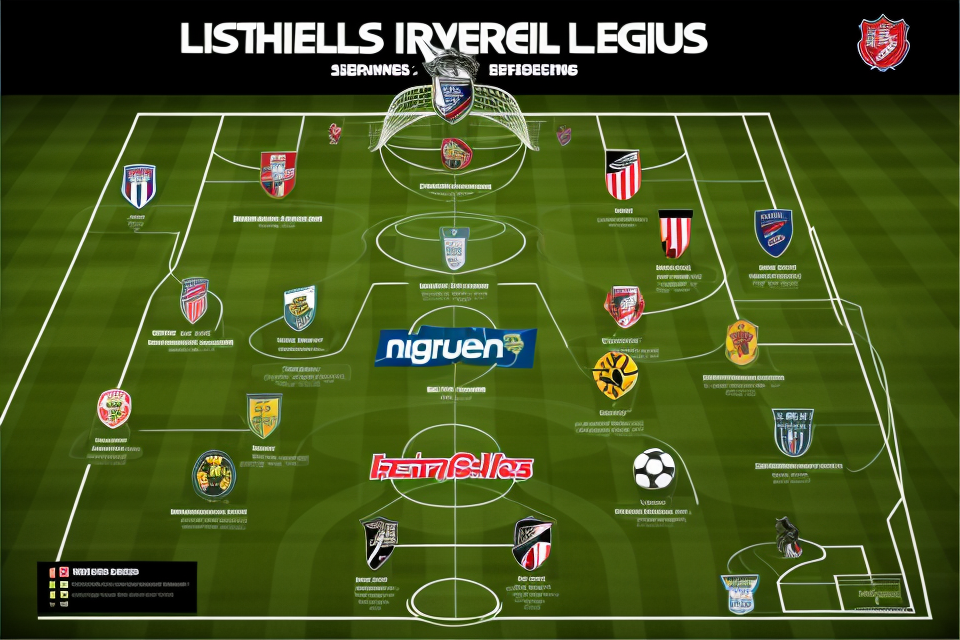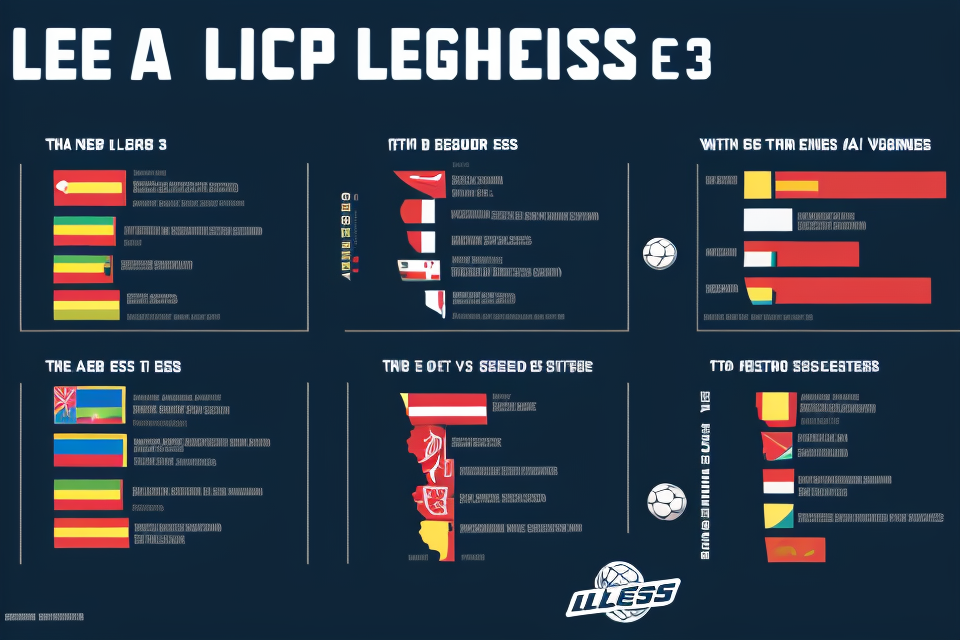English soccer, also known as football, is one of the most popular sports in the country. The Premier League is the top tier of English football, where the best teams and players compete against each other. But what lies below the Premier League? In this article, we will explore the hierarchy of English soccer leagues and take a closer look at the divisions that make up the beautiful game in England. From the Championship to League Two, we will uncover the history, culture, and excitement of each league and what makes them unique. So, buckle up and join us on this journey to discover the fascinating world of English soccer beyond the Premier League.
The Structure of English Soccer Leagues
The Premier League
The Premier League is the top tier of English soccer and is widely regarded as the highest level of professional football in England. It is a competition that features 20 teams, with each team playing a total of 38 matches throughout the season. The Premier League is renowned for its intense rivalries, passionate fan bases, and world-class players.
One of the unique aspects of the Premier League is that it operates on a system of promotion and relegation. At the end of each season, the bottom three teams are relegated to the Championship, while the top two teams from the Championship are promoted to the Premier League. This system ensures that there is always a sense of excitement and unpredictability in the Premier League, as teams fight to avoid relegation or challenge for the title.
Another important aspect of the Premier League is the vast amount of money that is generated by the competition. The Premier League is one of the richest soccer leagues in the world, with huge television deals and lucrative sponsorship agreements contributing to a massive revenue stream. This money is then distributed among the teams, with the majority going to the teams that finish higher in the table. As a result, the Premier League has become a breeding ground for some of the world’s most successful soccer clubs, with teams like Manchester United, Liverpool, and Chelsea regularly competing at the highest level of European soccer.
In conclusion, the Premier League is the pinnacle of English soccer and is a competition that is loved by millions of fans around the world. Its unique structure, passionate fan bases, and financial power make it one of the most exciting and dynamic soccer leagues in the world.
The English Football League (EFL)
The English Football League (EFL) is the second tier of English soccer, below the Premier League. It is comprised of three divisions: the Championship, League One, and League Two. The EFL is home to 72 teams, with 24 teams in the Championship, 24 teams in League One, and 24 teams in League Two.
Each division in the EFL has a set of promotion and relegation rules that determine which teams are promoted or relegated to a higher or lower division. The Championship is the highest division in the EFL, and the teams that finish in the top two positions are promoted to the Premier League. The teams that finish in the bottom four positions are relegated to League One.
League One is the second tier of the EFL, and the teams that finish in the top three positions are promoted to the Championship. The teams that finish in the bottom four positions are relegated to League Two.
League Two is the third tier of the EFL, and the teams that finish in the top seven positions are promoted to League One. The teams that finish in the bottom four positions are relegated to the National League, which is the fifth tier of English soccer.
The EFL also has a playoff system in place for each division, which allows teams that finish in the playoff positions to compete for a spot in the higher division. The playoffs are held at the end of the season and involve a two-legged tie between the teams that finished in the playoff positions. The winner of the tie earns a spot in the higher division.
Overall, the EFL is a crucial part of the English soccer pyramid, and it provides a pathway for teams to rise through the ranks and compete at the highest level of the sport.
The National League
The National League is the fifth tier of English soccer and is comprised of 22 teams. It serves as a crucial component of the football pyramid, featuring teams that compete at the bottom of the hierarchy. The National League is an important stepping stone for aspiring clubs seeking to climb the ranks and secure a spot in higher divisions.
Each team in the National League competes against one another in a round-robin format, with the top teams earning promotion to the National League North or South, depending on their geographical location. The bottom teams, on the other hand, risk relegation to the tier below, which could be the Northern Premier League or the Southern League, depending on their current placement.
The National League is a highly competitive and exciting league, with many young and talented players vying for their chance to make a name for themselves in the world of soccer. It is also a breeding ground for emerging managers and coaches, who seek to hone their skills and work their way up the ladder of success.
The league boasts a diverse range of clubs, each with their own unique histories and cultures. From former powerhouses looking to reclaim their glory days to smaller clubs fighting to maintain their status, the National League offers a fascinating glimpse into the world of English soccer outside of the Premier League.
In summary, the National League is a crucial part of the English soccer pyramid, providing a platform for teams to showcase their talent and fight for promotion to higher divisions. With its intense competition and rich history, it remains an important component of the beautiful game in England.
The Importance of Promotion and Relegation
Promotion
- The process by which teams are promoted from a lower league to a higher league
- Involves a points-based system and playoffs
- Determines which teams will participate in the higher league the following season
In the world of English soccer, promotion and relegation are two crucial concepts that dictate the fate of clubs. These processes determine which teams get to play in the higher leagues and which ones get relegated to the lower leagues. Among these, promotion is the key factor that allows clubs to rise through the ranks and reach the pinnacle of English soccer, the Premier League.
Promotion is the process by which teams are promoted from a lower league to a higher league. It is a competitive process that involves a points-based system and playoffs. The teams that are promoted to a higher league get to compete against better opponents and have a chance to earn more money through better attendance, media coverage, and sponsorship deals.
The points-based system is the first criterion for promotion. At the end of each season, the teams in each league are ranked based on their total points. The team with the most points is crowned the champion, while the teams that finish second, third, and so on, also earn promotion spots based on their rankings. The number of promotion spots varies depending on the league, but it usually ranges from one to four.
However, the points-based system is not always enough to determine the promotion spots. This is where the playoffs come into play. In the playoffs, the teams that have not earned promotion through the points-based system compete against each other in a knockout format. The winners of these playoffs earn the final promotion spots.
Promotion is a highly coveted achievement for teams that aspire to reach the Premier League. The higher league means more exposure, better facilities, and more money. It also means the chance to compete against the best teams in the country and possibly even in Europe. Therefore, teams that are promoted from lower leagues are always ecstatic and eager to prove themselves in the higher league.
Relegation
Relegation is the process by which teams are relegated from a higher league to a lower league. This is a common practice in many sports leagues around the world, including soccer. In the case of English soccer, relegation is a key part of the league system and helps to determine which teams will participate in the lower league the following season.
Relegation is typically determined by a points-based system, where teams earn points for each match they win or draw. The number of points a team earns is determined by the number of goals they score, with additional points awarded for winning matches. The team with the most points at the end of the season is promoted to the higher league, while the team with the fewest points is relegated to the lower league.
In some cases, the points-based system may not be enough to determine which teams are promoted or relegated. In these cases, playoffs may be used to determine the final spots in the higher or lower league. These playoffs may involve a single match or a series of matches, depending on the league and the number of teams involved.
Relegation can have a significant impact on a team’s finances and overall success. Teams that are relegated to a lower league may experience a decrease in revenue and attendance, as well as a decrease in their overall status and prestige. On the other hand, teams that are promoted to a higher league may experience an increase in revenue and attendance, as well as an increase in their overall status and prestige. As a result, relegation is a key part of the league system and helps to ensure that teams are competing at the appropriate level.
The Benefits and Drawbacks of the English Soccer League System
Benefits
Encourages competition and parity among teams
The English soccer league system is designed to promote competition and parity among teams, regardless of their size or financial resources. This ensures that every team has a chance to succeed, and that no team can rest on their laurels.
Provides opportunities for smaller clubs to rise through the ranks
The English soccer league system also provides opportunities for smaller clubs to rise through the ranks and achieve success. Smaller clubs often have lower budgets and fewer resources than larger clubs, but they can still compete and even beat their more well-known opponents. This creates a sense of excitement and unpredictability that keeps fans engaged and interested.
Attracts fans from across the country to watch games
Finally, the English soccer league system attracts fans from across the country to watch games. The top teams in the Premier League draw large crowds and generate significant revenue, but even smaller clubs can attract passionate and dedicated fans. This creates a vibrant and diverse soccer culture that is enjoyed by millions of people in England and around the world.
Drawbacks
Financial Instability for Clubs Promoted or Relegated
The English soccer league system can lead to financial instability for clubs that are promoted or relegated. Clubs that are promoted to a higher division may experience a significant increase in revenue due to higher attendance and television revenue. However, these clubs may also face increased expenses due to the higher standard of competition and the need to strengthen their squad to compete at a higher level. As a result, clubs that are promoted may struggle to maintain their financial stability, especially if they are not prepared for the increased costs.
On the other hand, clubs that are relegated to a lower division may experience a significant decrease in revenue due to lower attendance and television revenue. These clubs may also struggle to maintain their financial stability, especially if they are not prepared for the decrease in revenue. Relegated clubs may also find it difficult to attract top players due to the decreased financial resources, which can further impact their performance and quality of play.
Loss of Star Players Scouted by Larger Clubs
The English soccer league system can also result in the loss of star players who are scouted by larger clubs. Smaller clubs may rely on their star players to attract fans and generate revenue. However, larger clubs with greater financial resources may be able to offer more lucrative contracts and better opportunities for success, which can lure star players away from smaller clubs. As a result, smaller clubs may lose their star players, which can impact their performance and quality of play.
Moreover, the loss of star players can also impact the financial stability of smaller clubs. Star players may generate a significant portion of a club’s revenue through ticket sales, merchandise sales, and sponsorships. The loss of these players can result in a decrease in revenue, which can further impact the club’s financial stability.
Inconsistency in Team Performance and Quality of Play
The English soccer league system can also cause inconsistency in team performance and quality of play. Clubs that are promoted or relegated may experience a significant change in their squad and coaching staff, which can impact their performance on the field. Additionally, smaller clubs may struggle to compete with larger clubs due to the financial resources and infrastructure of larger clubs. As a result, smaller clubs may experience inconsistency in their performance and quality of play, which can impact their ability to achieve success and attract fans.
Furthermore, the English soccer league system may also cause inconsistency in the quality of play due to the disparity in resources and infrastructure between larger and smaller clubs. Larger clubs may have access to better training facilities, coaches, and players, which can impact their performance on the field. Additionally, the pressure to achieve success may be greater for larger clubs, which can impact their performance and quality of play.
Overall, the English soccer league system can have significant drawbacks for clubs that are promoted or relegated, lose star players, and experience inconsistency in team performance and quality of play. These drawbacks can impact the financial stability, success, and quality of play of clubs at all levels of the English soccer league system.
The Future of English Soccer Leagues
Potential Changes
- Expansion of the Premier League
- One potential change for the future of English soccer leagues is the expansion of the Premier League. The Premier League has been the top tier of English football since its inception in 1992, and it has remained a constant presence in the sport. However, with the growing popularity of football around the world, there have been calls for the Premier League to expand its membership to include more teams.
- This could potentially mean that more clubs would have the opportunity to compete at the highest level of English football, and it could also bring in more revenue for the league. However, it is important to note that expanding the Premier League could also dilute the quality of the league, as more teams would be included in the competition.
- Another factor to consider is the logistics of expanding the Premier League. It would require significant changes to the league structure, including the scheduling of games and the allocation of TV money. It would also require the approval of the current members of the Premier League, who may not be in favor of expanding the league.
- Ultimately, the decision to expand the Premier League will depend on a variety of factors, including the desires of the current members of the league and the potential impact on the quality of the competition.
- Introduction of a winter break
- Another potential change for the future of English soccer leagues is the introduction of a winter break. Currently, the Premier League is one of the only major European leagues that does not have a winter break. This means that teams in the Premier League play throughout the winter months, while other leagues take a break to allow players to rest and recover.
- The introduction of a winter break could potentially improve the quality of the Premier League, as it would give players a chance to rest and recover from injuries. It could also potentially reduce the number of postponed games due to inclement weather.
- However, there are also potential drawbacks to introducing a winter break. It could potentially disrupt the flow of the season, and it could also impact the scheduling of domestic and European cup competitions.
- Ultimately, the decision to introduce a winter break will depend on a variety of factors, including the desires of the current members of the league and the potential impact on the quality of the competition.
- Implementation of a salary cap
- Another potential change for the future of English soccer leagues is the implementation of a salary cap. Currently, there is no limit on the amount of money that clubs can spend on player wages in the Premier League. This has led to a situation where some clubs are able to spend vast amounts of money on player transfers and wages, while others are unable to compete financially.
- The implementation of a salary cap could potentially level the playing field in the Premier League, as it would prevent the richest clubs from spending vast amounts of money on player wages. It could also potentially reduce the cost of player transfers, as clubs would not be able to spend as much money on player wages.
- However, there are also potential drawbacks to implementing a salary cap. It could potentially reduce the quality of the Premier League, as it would prevent clubs from attracting the best players with lucrative contracts. It could also potentially lead to a reduction in revenue for clubs, as they would not be able to generate as much money from player transfers and wages.
- Ultimately, the decision to implement a salary cap will depend on a variety of factors, including the desires of the current members of the league and the potential impact on the quality of the competition.
Impact on English Soccer
Increased competition and parity
- Introduction of new leagues and competitions
- Promotion and relegation system
- Expansion of fan base and exposure
Greater financial stability for clubs
- Sponsorship deals
- TV rights revenue
- Commercial partnerships
Improved quality of play
- Investment in player development
- Access to better training facilities
- Attraction of top talent from around the world
The future of English soccer leagues holds much promise and potential for growth and development. With the introduction of new leagues and competitions, the promotion and relegation system, and the expansion of fan base and exposure, the level of competition and parity in the sport is expected to increase. Additionally, clubs are likely to benefit from increased financial stability through sponsorship deals, TV rights revenue, and commercial partnerships.
Another aspect that is expected to improve is the quality of play. With increased investment in player development, access to better training facilities, and the attraction of top talent from around the world, the level of skill and competitiveness on the field is likely to rise. This can only serve to enhance the overall experience for fans and make the sport even more exciting to watch.
Challenges and Concerns
As the English soccer leagues continue to evolve, several challenges and concerns have emerged that must be addressed in order to ensure the long-term success and sustainability of the sport. These challenges include balancing the needs of larger and smaller clubs, ensuring fairness and transparency in the league system, and addressing issues of player safety and well-being.
- Balancing the needs of larger and smaller clubs
One of the main challenges facing the English soccer leagues is balancing the needs of larger and smaller clubs. Larger clubs with greater financial resources often have an advantage over smaller clubs, which can lead to a lack of competitiveness and excitement in the lower leagues. However, smaller clubs are an important part of the sport’s history and tradition, and must be supported in order to ensure the continued growth and development of the sport.
- Ensuring fairness and transparency in the league system
Another challenge facing the English soccer leagues is ensuring fairness and transparency in the league system. The recent scandal involving Manchester City’s financial dealings serves as a reminder of the importance of ensuring that all clubs are playing by the same rules and that there is no corruption or fraud in the sport. In addition, the use of technology and data analysis in the sport has raised concerns about the potential for clubs to gain an unfair advantage through the use of advanced analytics and tactics.
- Addressing issues of player safety and well-being
Finally, the English soccer leagues must also address issues of player safety and well-being. The sport is known for its physicality and intensity, and players are often subjected to grueling training and demanding schedules. In addition, concerns have been raised about the long-term effects of head injuries and other forms of physical trauma on players’ health and well-being. As such, it is important for the leagues to take steps to ensure that players are protected and supported both on and off the field.
FAQs
1. What is the Premier League?
The Premier League is the highest level of professional football in England. It is a league competition where 20 teams compete against each other throughout the season. The Premier League is known for its high-quality football, competitive matches, and world-class players.
2. What is the hierarchy of English soccer leagues?
The English soccer league system is a hierarchical structure that consists of several leagues, each level below the Premier League. The leagues below the Premier League are the English Football League (EFL), which includes the Championship, League One, and League Two. The National League is the fifth tier of English football and is the highest level of non-league football.
3. What is the English Football League (EFL)?
The English Football League (EFL) is the second tier of professional football in England, below the Premier League. It is a league competition that includes 24 teams that compete against each other throughout the season. The EFL is known for its competitive matches and is a crucial stepping stone for teams looking to reach the Premier League.
4. What is the National League?
The National League is the fifth tier of English football and is the highest level of non-league football. It is a league competition that includes 24 teams that compete against each other throughout the season. The National League is known for its competitive matches and is a crucial stepping stone for teams looking to reach the EFL.
5. What is the difference between the Premier League and the EFL?
The Premier League is the highest level of professional football in England, while the EFL is the second tier of professional football in England. The Premier League features 20 teams that compete against each other throughout the season, while the EFL features 24 teams that compete against each other throughout the season. The Premier League is known for its high-quality football, competitive matches, and world-class players, while the EFL is known for its competitive matches and is a crucial stepping stone for teams looking to reach the Premier League.



